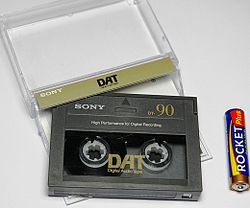Digital audio tape
 |
|

A 90-minute DAT cartridge, size compared to a AAA (LR03) battery.
|
|
| Media type | Magnetic tape |
|---|---|
| Encoding | Lossless real-time |
| Capacity | Up to 120 or 180 minutes (consumer tapes on non-LP mode) |
| Read mechanism | Rotating head |
| Write mechanism | Rotating head, helical scan |
| Developed by | Sony |
| Usage | Audio storage |
Digital Audio Tape (DAT or R-DAT) is a signal recording and playback medium developed by Sony and introduced in 1987. In appearance it is similar to a Compact Cassette, using 3.81 mm / 0.15" (commonly referred to as 4 mm) magnetic tape enclosed in a protective shell, but is roughly half the size at 73 mm × 54 mm × 10.5 mm. As the name suggests, the recording is digital rather than analog. DAT has the ability to record at higher, equal or lower sampling rates than a CD (48, 44.1 or 32 kHz sampling rate respectively) at 16 bits quantization. If a digital source is copied then the DAT will produce an exact clone, unlike other digital media such as Digital Compact Cassette or non-Hi-MD MiniDisc, both of which use a lossy data reduction system.
Like most formats of videocassette, a DAT cassette may only be recorded and played in one direction, unlike an analog compact audio cassette, although many DAT recorders had the capability to record program numbers and IDs, which can be used to select an individual track like on a CD player.
Although intended as a replacement for analog audio compact cassettes, the format was never widely adopted by consumers because of issues of expense and concerns from the music industry about unauthorized high-quality copies. The format saw moderate success in professional markets and as a computer storage medium, which was developed into the Digital Data Storage format. As Sony has ceased production of new recorders, it will become more difficult to play archived recordings in this format unless they are copied to other formats or hard drives.
The technology of DAT is closely based on that of video recorders, using a rotating head and helical scan to record data. This prevents DATs from being physically edited in the cut-and-splice manner of analog tapes, or open-reel digital tapes like ProDigi or DASH.
...
Wikipedia
